#Amazon VPC
Explore tagged Tumblr posts
Text
15. Was sind die Top-AWS-Services für Unternehmen?: Hallo Manuel! Der Titel des Blog-Beitrags lautet: "Die Top-AWS-Services für Unternehmen: Wie MHM Digitale Lösungen UG Ihnen bei der Auswahl hilft".
#AWS #CloudServices #AmazonEC2 #AmazonS3 #AmazonRDS #AmazonVPC #AmazonCloudFront #AWSLambda #AmazonECS #AmazonElasticBeanstalk #AWSGlue #AmazonKinesis - Welche AWS-Services helfen Unternehmen, ihre digitale Transformation voranzutreiben? Lerne mehr darüber im MHM Digitale Lösungen UG Blog-Beitrag!
Amazon Web Services (AWS) bietet Unternehmen eine breite Palette an Cloud-Computing-Services, um ihnen dabei zu helfen, digitale Lösungen zu erstellen und zu implementieren. Unternehmen können aus einer Vielzahl an Services wählen: von Computing über Datenbanken und Netzwerkinfrastruktur bis hin zu Entwicklungs-Tools. Während es schwierig ist, die richtige Auswahl zu treffen, kann die MHM…
View On WordPress
#Amazon CloudFront#Amazon ECS#Amazon Elastic Beanstalk#Amazon RDS#Amazon S3#Amazon VPC#AWS Glue und Amazon Kinesis.#AWS Lambda#Hier ist deine Liste mit den Top-AWS-Services für Unternehmen: Amazon EC2
0 notes
Text
Virtual Private Cloud (VPC) Flow Logs in Amazon Web Services (AWS) is an indispensable feature for developers, network administrators, and cybersecurity professionals. It provides a window into the network traffic flowing through your AWS environment, providing the visibility needed to monitor, troubleshoot, and secure your applications and resources efficiently.
2 notes
·
View notes
Text
PCS AWS: AWS Parallel Computing Service For HPC workloads
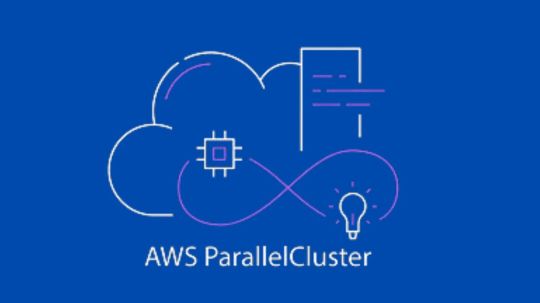
PCS AWS
AWS launching AWS Parallel Computing Service (AWS PCS), a managed service that allows clients build up and maintain HPC clusters to execute simulations at nearly any scale on AWS. The Slurm scheduler lets them work in a familiar HPC environment without worrying about infrastructure, accelerating outcomes.
AWS Parallel Computing
Run HPC workloads effortlessly at any scale.
Why AWS PCS?
AWS Parallel Computing Service (AWS PCS) is a managed service that simplifies HPC workloads and Slurm-based scientific and engineering model development on AWS. PCS AWS lets you create elastic computing, storage, networking, and visualization environments. Managed updates and built-in observability features make cluster management easier with AWS PCS. You may focus on research and innovation in a comfortable environment without worrying about infrastructure.
Benefits
Focus on labor, not infrastructure
Give users comprehensive HPC environments that scale to run simulations and scientific and engineering modeling without code or script changes to boost productivity.
Manage, secure, and scale HPC clusters
Build and deploy scalable, dependable, and secure HPC clusters via the AWS Management Console, CLI, or SDK.
HPC solutions using flexible building blocks
Build and maintain end-to-end HPC applications on AWS using highly available cluster APIs and infrastructure as code.
Use cases
Tightly connected tasks
At almost any scale, run concurrent MPI applications like CAE, weather and climate modeling, and seismic and reservoir simulation efficiently.
Faster computing
GPUs, FPGAs, and Amazon-custom silicon like AWS Trainium and AWS Inferentia can speed up varied workloads like creating scientific and engineering models, protein structure prediction, and Cryo-EM.
Computing at high speed and loosely linked workloads
Distributed applications like Monte Carlo simulations, image processing, and genomics research can run on AWS at any scale.
Workflows that interact
Use human-in-the-loop operations to prepare inputs, run simulations, visualize and evaluate results in real time, and modify additional trials.
AWS ParallelCluster
In November 2018, AWS launched AWS ParallelCluster, an AWS-supported open-source cluster management tool for AWS Cloud HPC cluster deployment and maintenance. Customers can quickly design and deploy proof of concept and production HPC computation systems with AWS ParallelCluster. Open-source AWS ParallelCluster Command-Line interface, API, Python library, and user interface are available. Updates may include cluster removal and reinstallation. To eliminate HPC environment building and operation chores, many clients have requested a completely managed AWS solution.
AWS Parallel Computing Service (AWS PCS)
PCS AWS simplifies AWS-managed HPC setups via the AWS Management Console, SDK, and CLI. Your system administrators can establish managed Slurm clusters using their computing, storage, identity, and job allocation preferences. AWS PCS schedules and orchestrates simulations using Slurm, a scalable, fault-tolerant work scheduler utilized by many HPC clients. Scientists, researchers, and engineers can log into AWS PCS clusters to conduct HPC jobs, use interactive software on virtual desktops, and access data. Their workloads can be swiftly moved to PCS AWS without code porting.
Fully controlled NICE DCV remote desktops allow specialists to manage HPC operations in one place by accessing task telemetry or application logs and remote visualization.
PCS AWS uses familiar methods for preparing, executing, and analyzing simulations and computations for a wide range of traditional and emerging, compute or data-intensive engineering and scientific workloads in computational reservoir simulations, electronic design automation, finite element analysis, fluid dynamics, and weather modeling.
Starting AWS Parallel Computing Service
AWS documentation article for constructing a basic cluster lets you try AWS PCS. First, construct a VPC with an AWS CloudFormation template and shared storage in Amazon EFS in your account for the AWS Region where you will try PCS AWS. AWS literature explains how to create a VPC and shared storage.
Cluster
Select Create cluster in the PCS AWS console to manage resources and run workloads.
Name your cluster and select your Slurm scheduler controller size. Cluster workload limits are Small (32 nodes, 256 jobs), Medium (512 nodes, 8,192 tasks), and Large (2,048 nodes, 16,384 jobs). Select your VPC, cluster launch subnet, and cluster security group in Networking.
A resource selection method parameter, an idle duration before compute nodes scale down, and a Prolog and Epilog scripts directory on launched compute nodes are optional Slurm configurations.
Create cluster. Provisioning the cluster takes time.
Form compute node groupings
After constructing your cluster, you can create compute node groups, a virtual grouping of Amazon EC2 instances used by PCS AWS to enable interactive access to a cluster or perform processes in it. You define EC2 instance types, minimum and maximum instance counts, target VPC subnets, Amazon Machine Image (AMI), purchasing option, and custom launch settings when defining a compute node group. Compute node groups need an instance profile to pass an AWS IAM role to an EC2 instance and an EC2 launch template for AWS PCS to configure EC2 instances.
Select the Compute node groups tab and the Create button in your cluster to create a compute node group in the console.
End users can login to a compute node group, and HPC jobs run on a job node group.
Use a compute node name and a previously prepared EC2 launch template, IAM instance profile, and subnets to launch compute nodes in your cluster VPC for HPC jobs.
Next, select your chosen EC2 instance types for compute node launches and the scaling minimum and maximum instance count.
Select Create. Provisioning the computing node group takes time.
Build and run HPC jobs
After building compute node groups, queue a job to run. Job queued until PCS AWS schedules it on a compute node group based on provisioned capacity. Each queue has one or more computing node groups that supply EC2 instances for processing.
Visit your cluster, select Queues, and click Create queue to create a queue in the console.
Select Create and wait for queue creation.
AWS Systems Manager can connect to the EC2 instance it creates when the login compute node group is active. Select your login compute node group EC2 instance in the Amazon EC2 console. The AWS manual describes how to create a queue to submit and manage jobs and connect to your cluster.
Create a submission script with job requirements and submit it to a queue with the sbatch command to perform a Slurm job. This is usually done from a shared directory so login and compute nodes can access files together.
Slurm may perform MPI jobs in PCS AWS. See AWS documents Run a single-node job with Slurm or Run a multi-node MPI task with Slurm for details.
Visualize with a fully managed NICE DCV remote desktop. Start with the HPC Recipes for AWS GitHub CloudFormation template.
After HPC jobs using your cluster and node groups, erase your resources to minimize needless expenses. See AWS documentation Delete your AWS resources for details.
Know something
Some things to know about this feature:
Slurm versions – AWS PCS initially supports Slurm 23.11 and enables tools to upgrade major versions when new versions are added. AWS PCS also automatically patches the Slurm controller.
On-Demand Capacity Reservations let you reserve EC2 capacity in a certain Availability Zone and duration to ensure you have compute capacity when you need it.
Network file systems Amazon FSx for NetApp ONTAP, OpenZFS, File Cache, EFS, and Lustre can be attached to write and access data and files. Self-managed volumes like NFS servers are possible.
Now available
US East (N. Virginia), US East (Ohio), US West (Oregon), Asia Pacific (Singapore), Asia Pacific (Sydney), Asia Pacific (Tokyo), Europe (Frankfurt), Europe (Ireland), and Europe (Stockholm) now provide AWS Parallel Computing Service.
Read more on govindhtech.com
#PCS#AWS#computingservice#hpcworkloads#parallelcomputingservice#awspcs#Amazon#vpc#amazonec2instance#news#TechNews#technology#technologynews#technologytrends#govindhtech
0 notes
Text
VPC, Subnet, NACL, Security Group: Create your own Network on AWS from Scratch [Part 2]
Amazon Virtual Private Cloud (Amazon VPC) enables you to launch AWS resources in a logically isolated virtual network that you have created. This virtual network closely resembles a traditional network that you’d operate in your own data centre, with the benefits of using the scalable infrastructure of AWS. Please see how to Build a Scalable VPC for Your AWS Environment [Part 1], how to Hide or…

View On WordPress
#Amazon Virtual Private Cloud (Amazon VPC)#AWS#AWS Resource Map#AWS Virtual Private Cloud#AWS VPC#Best Practices for Creating a VPC#NACL#Network Access Control Lists
0 notes
Text
BRB... just upgrading Python
CW: nerdy, technical details.
Originally, MLTSHP (well, MLKSHK back then) was developed for Python 2. That was fine for 2010, but 15 years later, and Python 2 is now pretty ancient and unsupported. January 1st, 2020 was the official sunset for Python 2, and 5 years later, we’re still running things with it. It’s served us well, but we have to transition to Python 3.
Well, I bit the bullet and started working on that in earnest in 2023. The end of that work resulted in a working version of MLTSHP on Python 3. So, just ship it, right? Well, the upgrade process basically required upgrading all Python dependencies as well. And some (flyingcow, torndb, in particular) were never really official, public packages, so those had to be adopted into MLTSHP and upgraded as well. With all those changes, it required some special handling. Namely, setting up an additional web server that could be tested against the production database (unit tests can only go so far).
Here’s what that change comprised: 148 files changed, 1923 insertions, 1725 deletions. Most of those changes were part of the first commit for this branch, made on July 9, 2023 (118 files changed).
But by the end of that July, I took a break from this task - I could tell it wasn’t something I could tackle in my spare time at that time.
Time passes…
Fast forward to late 2024, and I take some time to revisit the Python 3 release work. Making a production web server for the new Python 3 instance was another big update, since I wanted the Docker container OS to be on the latest LTS edition of Ubuntu. For 2023, that was 20.04, but in 2025, it’s 24.04. I also wanted others to be able to test the server, which means the CDN layer would have to be updated to direct traffic to the test server (without affecting general traffic); I went with a client-side cookie that could target the Python 3 canary instance.
In addition to these upgrades, there were others to consider — MySQL, for one. We’ve been running MySQL 5, but version 9 is out. We settled on version 8 for now, but could also upgrade to 8.4… 8.0 is just the version you get for Ubuntu 24.04. RabbitMQ was another server component that was getting behind (3.5.7), so upgrading it to 3.12.1 (latest version for Ubuntu 24.04) seemed proper.
One more thing - our datacenter. We’ve been using Linode’s Fremont region since 2017. It’s been fine, but there are some emerging Linode features that I’ve been wanting. VPC support, for one. And object storage (basically the same as Amazon’s S3, but local, so no egress cost to-from Linode servers). Both were unavailable to Fremont, so I decided to go with their Chicago region for the upgrade.
Now we’re talking… this is now not just a “push a button” release, but a full-fleged, build everything up and tear everything down kind of release that might actually have some downtime (while trying to keep it short)!
I built a release plan document and worked through it. The key to the smooth upgrade I want was to make the cutover as seamless as possible. Picture it: once everything is set up for the new service in Chicago - new database host, new web servers and all, what do we need to do to make the switch almost instant? It’s Fastly, our CDN service.
All traffic to our service runs through Fastly. A request to the site comes in, Fastly routes it to the appropriate host, which in turns speaks to the appropriate database. So, to transition from one datacenter to the other, we need to basically change the hosts Fastly speaks to. Those hosts will already be set to talk to the new database. But that’s a key wrinkle - the new database…
The new database needs the data from the old database. And to make for a seamless transition, it needs to be up to the second in step with the old database. To do that, we have take a copy of the production data and get it up and running on the new database. Then, we need to have some process that will copy any new data to it since the last sync. This sounded a lot like replication to me, but the more I looked at doing it that way, I wasn’t confident I could set that up without bringing the production server down. That’s because any replica needs to start in a synchronized state. You can’t really achieve that with a live database. So, instead, I created my own sync process that would copy new data on a periodic basis as it came in.
Beyond this, we need a proper replication going in the new datacenter. In case the database server goes away unexpectedly, a replica of it allows for faster recovery and some peace of mind. Logical backups can be made from the replica and stored in Linode’s object storage if something really disastrous happens (like tables getting deleted by some intruder or a bad data migration).
I wanted better monitoring, too. We’ve been using Linode’s Longview service and that’s okay and free, but it doesn’t act on anything that might be going wrong. I decided to license M/Monit for this. M/Monit is so lightweight and nice, along with Monit running on each server to keep track of each service needed to operate stuff. Monit can be given instructions on how to self-heal certain things, but also provides alerts if something needs manual attention.
And finally, Linode’s Chicago region supports a proper VPC setup, which allows for all the connectivity between our servers to be totally private to their own subnet. It also means that I was able to set up an additional small Linode instance to serve as a bastion host - a server that can be used for a secure connection to reach the other servers on the private subnet. This is a lot more secure than before… we’ve never had a breach (at least, not to my knowledge), and this makes that even less likely going forward. Remote access via SSH is now unavailable without using the bastion server, so we don’t have to expose our servers to potential future ssh vulnerabilities.
So, to summarize: the MLTSHP Python 3 upgrade grew from a code release to a full stack upgrade, involving touching just about every layer of the backend of MLTSHP.
Here’s a before / after picture of some of the bigger software updates applied (apologies for using images for these tables, but Tumblr doesn’t do tables):
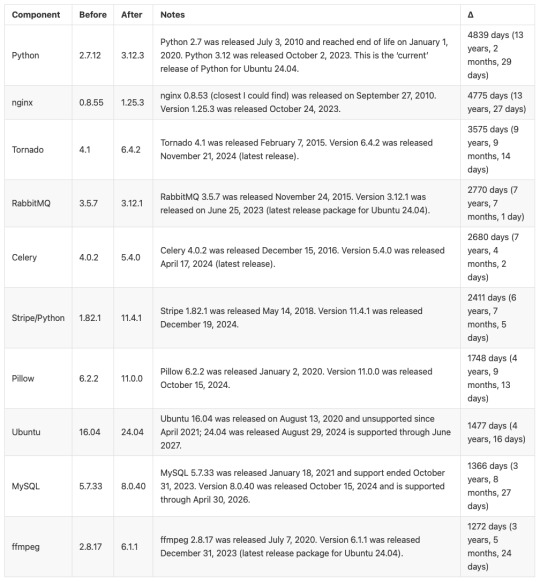
And a summary of infrastructure updates:

I’m pretty happy with how this has turned out. And I learned a lot. I’m a full-stack developer, so I’m familiar with a lot of devops concepts, but actually doing that role is newish to me. I got to learn how to set up a proper secure subnet for our set of hosts, making them more secure than before. I learned more about Fastly configuration, about WireGuard, about MySQL replication, and about deploying a large update to a live site with little to no downtime. A lot of that is due to meticulous release planning and careful execution. The secret for that is to think through each and every step - no matter how small. Document it, and consider the side effects of each. And with each step that could affect the public service, consider the rollback process, just in case it’s needed.
At this time, the server migration is complete and things are running smoothly. Hopefully we won’t need to do everything at once again, but we have a recipe if it comes to that.
15 notes
·
View notes
Text
AWS Security 101: Protecting Your Cloud Investments
In the ever-evolving landscape of technology, few names resonate as strongly as Amazon.com. This global giant, known for its e-commerce prowess, has a lesser-known but equally influential arm: Amazon Web Services (AWS). AWS is a powerhouse in the world of cloud computing, offering a vast and sophisticated array of services and products. In this comprehensive guide, we'll embark on a journey to explore the facets and features of AWS that make it a driving force for individuals, companies, and organizations seeking to utilise cloud computing to its fullest capacity.

Amazon Web Services (AWS): A Technological Titan
At its core, AWS is a cloud computing platform that empowers users to create, deploy, and manage applications and infrastructure with unparalleled scalability, flexibility, and cost-effectiveness. It's not just a platform; it's a digital transformation enabler. Let's dive deeper into some of the key components and features that define AWS:
1. Compute Services: The Heart of Scalability
AWS boasts services like Amazon EC2 (Elastic Compute Cloud), a scalable virtual server solution, and AWS Lambda for serverless computing. These services provide users with the capability to efficiently run applications and workloads with precision and ease. Whether you need to host a simple website or power a complex data-processing application, AWS's compute services have you covered.
2. Storage Services: Your Data's Secure Haven
In the age of data, storage is paramount. AWS offers a diverse set of storage options. Amazon S3 (Simple Storage Service) caters to scalable object storage needs, while Amazon EBS (Elastic Block Store) is ideal for block storage requirements. For archival purposes, Amazon Glacier is the go-to solution. This comprehensive array of storage choices ensures that diverse storage needs are met, and your data is stored securely.
3. Database Services: Managing Complexity with Ease
AWS provides managed database services that simplify the complexity of database management. Amazon RDS (Relational Database Service) is perfect for relational databases, while Amazon DynamoDB offers a seamless solution for NoSQL databases. Amazon Redshift, on the other hand, caters to data warehousing needs. These services take the headache out of database administration, allowing you to focus on innovation.
4. Networking Services: Building Strong Connections
Network isolation and robust networking capabilities are made easy with Amazon VPC (Virtual Private Cloud). AWS Direct Connect facilitates dedicated network connections, and Amazon Route 53 takes care of DNS services, ensuring that your network needs are comprehensively addressed. In an era where connectivity is king, AWS's networking services rule the realm.
5. Security and Identity: Fortifying the Digital Fortress
In a world where data security is non-negotiable, AWS prioritizes security with services like AWS IAM (Identity and Access Management) for access control and AWS KMS (Key Management Service) for encryption key management. Your data remains fortified, and access is strictly controlled, giving you peace of mind in the digital age.
6. Analytics and Machine Learning: Unleashing the Power of Data
In the era of big data and machine learning, AWS is at the forefront. Services like Amazon EMR (Elastic MapReduce) handle big data processing, while Amazon SageMaker provides the tools for developing and training machine learning models. Your data becomes a strategic asset, and innovation knows no bounds.
7. Application Integration: Seamlessness in Action
AWS fosters seamless application integration with services like Amazon SQS (Simple Queue Service) for message queuing and Amazon SNS (Simple Notification Service) for event-driven communication. Your applications work together harmoniously, creating a cohesive digital ecosystem.
8. Developer Tools: Powering Innovation
AWS equips developers with a suite of powerful tools, including AWS CodeDeploy, AWS CodeCommit, and AWS CodeBuild. These tools simplify software development and deployment processes, allowing your teams to focus on innovation and productivity.
9. Management and Monitoring: Streamlined Resource Control
Effective resource management and monitoring are facilitated by AWS CloudWatch for monitoring and AWS CloudFormation for infrastructure as code (IaC) management. Managing your cloud resources becomes a streamlined and efficient process, reducing operational overhead.
10. Global Reach: Empowering Global Presence
With data centers, known as Availability Zones, scattered across multiple regions worldwide, AWS enables users to deploy applications close to end-users. This results in optimal performance and latency, crucial for global digital operations.
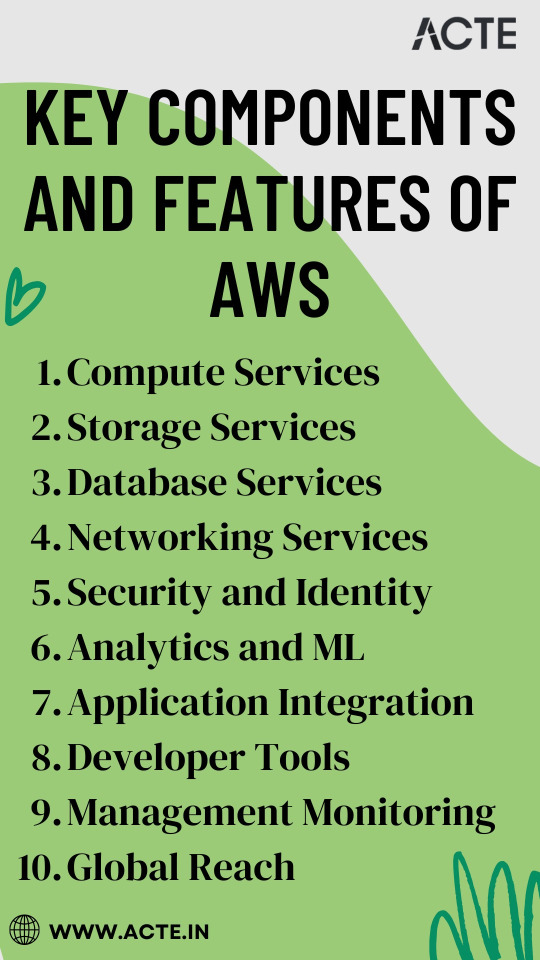
In conclusion, Amazon Web Services (AWS) is not just a cloud computing platform; it's a technological titan that empowers organizations and individuals to harness the full potential of cloud computing. Whether you're an aspiring IT professional looking to build a career in the cloud or a seasoned expert seeking to sharpen your skills, understanding AWS is paramount.
In today's technology-driven landscape, AWS expertise opens doors to endless opportunities. At ACTE Institute, we recognize the transformative power of AWS, and we offer comprehensive training programs to help individuals and organizations master the AWS platform. We are your trusted partner on the journey of continuous learning and professional growth. Embrace AWS, embark on a path of limitless possibilities in the world of technology, and let ACTE Institute be your guiding light. Your potential awaits, and together, we can reach new heights in the ever-evolving world of cloud computing. Welcome to the AWS Advantage, and let's explore the boundless horizons of technology together!
8 notes
·
View notes
Text
Navigating the Cloud Landscape: Unleashing Amazon Web Services (AWS) Potential
In the ever-evolving tech landscape, businesses are in a constant quest for innovation, scalability, and operational optimization. Enter Amazon Web Services (AWS), a robust cloud computing juggernaut offering a versatile suite of services tailored to diverse business requirements. This blog explores the myriad applications of AWS across various sectors, providing a transformative journey through the cloud.
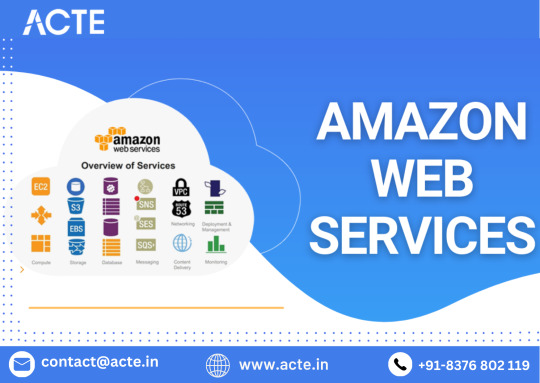
Harnessing Computational Agility with Amazon EC2
Central to the AWS ecosystem is Amazon EC2 (Elastic Compute Cloud), a pivotal player reshaping the cloud computing paradigm. Offering scalable virtual servers, EC2 empowers users to seamlessly run applications and manage computing resources. This adaptability enables businesses to dynamically adjust computational capacity, ensuring optimal performance and cost-effectiveness.
Redefining Storage Solutions
AWS addresses the critical need for scalable and secure storage through services such as Amazon S3 (Simple Storage Service) and Amazon EBS (Elastic Block Store). S3 acts as a dependable object storage solution for data backup, archiving, and content distribution. Meanwhile, EBS provides persistent block-level storage designed for EC2 instances, guaranteeing data integrity and accessibility.
Streamlined Database Management: Amazon RDS and DynamoDB
Database management undergoes a transformation with Amazon RDS, simplifying the setup, operation, and scaling of relational databases. Be it MySQL, PostgreSQL, or SQL Server, RDS provides a frictionless environment for managing diverse database workloads. For enthusiasts of NoSQL, Amazon DynamoDB steps in as a swift and flexible solution for document and key-value data storage.
Networking Mastery: Amazon VPC and Route 53
AWS empowers users to construct a virtual sanctuary for their resources through Amazon VPC (Virtual Private Cloud). This virtual network facilitates the launch of AWS resources within a user-defined space, enhancing security and control. Simultaneously, Amazon Route 53, a scalable DNS web service, ensures seamless routing of end-user requests to globally distributed endpoints.
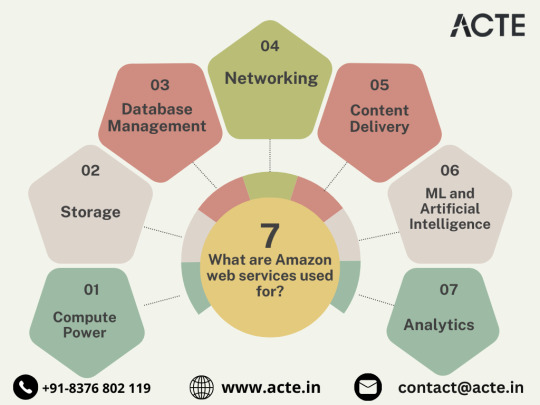
Global Content Delivery Excellence with Amazon CloudFront
Amazon CloudFront emerges as a dynamic content delivery network (CDN) service, securely delivering data, videos, applications, and APIs on a global scale. This ensures low latency and high transfer speeds, elevating user experiences across diverse geographical locations.
AI and ML Prowess Unleashed
AWS propels businesses into the future with advanced machine learning and artificial intelligence services. Amazon SageMaker, a fully managed service, enables developers to rapidly build, train, and deploy machine learning models. Additionally, Amazon Rekognition provides sophisticated image and video analysis, supporting applications in facial recognition, object detection, and content moderation.
Big Data Mastery: Amazon Redshift and Athena
For organizations grappling with massive datasets, AWS offers Amazon Redshift, a fully managed data warehouse service. It facilitates the execution of complex queries on large datasets, empowering informed decision-making. Simultaneously, Amazon Athena allows users to analyze data in Amazon S3 using standard SQL queries, unlocking invaluable insights.
In conclusion, Amazon Web Services (AWS) stands as an all-encompassing cloud computing platform, empowering businesses to innovate, scale, and optimize operations. From adaptable compute power and secure storage solutions to cutting-edge AI and ML capabilities, AWS serves as a robust foundation for organizations navigating the digital frontier. Embrace the limitless potential of cloud computing with AWS – where innovation knows no bounds.
3 notes
·
View notes
Text
Becoming an AWS Solutions Architect: A Comprehensive Guide
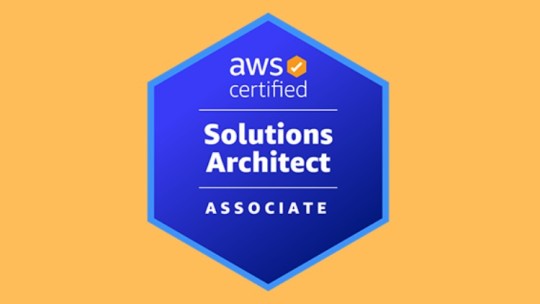
With the cloud age now, businesses are increasingly employing cloud computing platforms to cut costs, automate processes, and innovate. Among the first to pioneer cloud platforms is Amazon Web Services (AWS), which has numerous services that small, medium, and large enterprises can leverage. In order to effectively manage and optimize the services, businesses hire AWS Solutions Architects. What does it take to be an AWS Solutions Architect, and what is an AWS Solutions Architect in a business?
What is an AWS Solutions Architect?
AWS Solutions Architect is a technical professional who has the job to design, deploy, and execute scalable, secure, and high-performing cloud applications on Amazon Web Services. He cooperates with the development teams and clients in a manner that the architecture should be as per the business requirement and utilize the functionalities of AWS in the best way possible.
AWS Solutions Architects have knowledge in cloud architecture, system design, networking, and security. AWS Solutions Architects provide best-practice recommendations, cost savings, performance, and disaster recovery. AWS architects lead the way to help organizations realize maximum value of AWS in an effort to accomplish their missions.
Key Responsibilities of an AWS Solutions Architect
The work of an AWS Solutions Architect is diverse with numerous varied jobs. The essential jobs of an AWS Solutions Architect are:
Cloud Solution Design: Solutions Architects interact with stakeholders to receive business requirements and create cloud solutions that satisfy the requirements. It is performed by selecting suitable AWS services, stacking them in an open style, and designing highly available and fault-tolerant systems.
AWS Resource Monitoring and Management: They must monitor deploying and managing AWS resources such as EC2 instances, S3 buckets, RDS databases, etc. Resources must be ensured to scale as well as get optimized accordingly based on anticipated demands.
Security and Compliance: AWS Solutions Architects deploy cloud infrastructure with best-in-class security. They use encryption, access management, and identity practices to protect against sensitive information. They enable organizational compliance requirements.
Cost Optimization: Yet another of the biggest challenges of cloud deployment is managing costs. AWS Solutions Architects take into consideration usage patterns and suggest spending reduction without affecting performance. It could be selecting cost-effective services, rightsizing instances, or Reserved Instances.
Troubleshooting and Support: AWS Solutions Architects identify and fix cloud infrastructure issues. They collaborate with operations and development teams to address technical issues, ensuring the cloud environment remains up and running.
Skills and Certifications for AWS Solutions Architects
To become an AWS Solutions Architect, the candidate must possess technical as well as soft skills. Some of the most important skills and certifications are listed below:
Technical Skills
AWS Services: Strong knowledge of AWS services such as EC2, S3, Lambda, CloudFormation, VPC, and RDS.
Cloud Architecture: Experienced in designing scalable, highly available, and fault-tolerant architecture on AWS.
Networking and Security: Clear knowledge of networking fundamentals, firewalls, load balancers, and security controls in the AWS environment.
DevOps Tools: Knowledge of automated tools such as Terraform, Ansible, and CloudFormation for managing infrastructure.
Soft Skills
Problem-Solving: Solutions Architects need to have effective communication skills, wherein they can analyze and develop possible solutions to complex issues.
Communication: There is a requirement of good communication skills from the job with an effort to communicate clearly with development teams, stakeholders, and clients.
Project Management: Doing work under a series of varied projects and best possible ordering of tasks must be managed for the job.
Certifications
Experience is prioritized most, but certification aids in generating experience and interest towards learning accomplishments. AWS offers various certifications which are:
AWS Certified Solutions Architect – Associate: It is one of the recent additions in cloud architecture.
AWS Certified Solutions Architect – Professional: It is professional certification reflecting improved knowledge of AWS services and architecture design.
AWS Certified Security Specialty: It is AWS security practice-based certification.
Career Path and Opportunities for AWS Solutions Architects
The career of AWS Solutions Architects is slowly gaining momentum with more and more businesses shifting to the cloud. They begin as a cloud engineer, systems architect, or DevOps engineer in most scenarios. With the right skills, an AWS Solutions Architect can transition to senior positions such as cloud architect, enterprise architect, or even Chief Technology Officer (CTO).
Also, the majority of AWS Solutions Architects are independent consultants for various companies, and some are contracted by large companies, consulting firms, or tech companies. The profession has vast opportunities for advancement as well as work-life balance.
Conclusion
One must have a mix of technical expertise, problem-solving abilities, and in-depth knowledge regarding AWS services as well as cloud computing principles to be an AWS Solutions Architect. With cheap, safe, and adaptable cloud architecture, AWS Solutions Architects enable cloud success for companies. With more and more companies jumping on the cloud bandwagon every day, there is an endless future waiting to be taken by talented AWS Solutions Architects in a company that is expanding exponentially with profits only remaining for the rest.
0 notes
Text
A Deep Dive into Amazon Redshift: Your Guide to Cloud Data Warehousing
In the era of big data, organizations are increasingly turning to cloud solutions for efficient data management and analysis. Amazon Redshift, a prominent service from Amazon Web Services (AWS), has become a go-to choice for businesses looking to optimize their data warehousing capabilities. In this blog, we will explore what Amazon Redshift is, its architecture, features, and how it can transform your approach to data analytics.
If you want to advance your career at the AWS Course in Pune, you need to take a systematic approach and join up for a course that best suits your interests and will greatly expand your learning path.
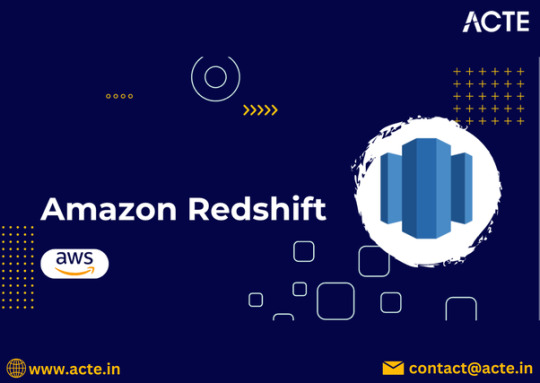
What is Amazon Redshift?
Amazon Redshift is a fully managed, cloud-based data warehouse service designed to handle large-scale data processing and analytics. It enables businesses to analyze vast amounts of structured and semi-structured data quickly and efficiently. With its architecture tailored for high performance, Redshift allows users to run complex queries and generate insights in real time.
The Architecture of Amazon Redshift
Understanding the architecture of Redshift is crucial to appreciating its capabilities. Here are the key components:
1. Columnar Storage
Unlike traditional row-based databases, Redshift uses a columnar storage model. This approach allows for more efficient data retrieval, as only the necessary columns are accessed during queries, significantly speeding up performance.
2. Massively Parallel Processing (MPP)
Redshift employs a massively parallel processing architecture, distributing workloads across multiple nodes. This means that queries can be processed simultaneously, enhancing speed and efficiency.
3. Data Compression
Redshift automatically compresses data to save storage space and improve query performance. By reducing the amount of data that needs to be scanned, it accelerates query execution.
4. Snapshots and Backups
Redshift provides automated snapshots of your data warehouse. This feature ensures data durability and allows for easy restoration in case of failure, enhancing data security.
To master the intricacies of AWS and unlock its full potential, individuals can benefit from enrolling in the AWS Online Training.

Key Features of Amazon Redshift
1. Scalability
Redshift is designed to grow with your data. You can start with a small data warehouse and scale up to petabytes as your data needs expand. This scalability is vital for businesses experiencing rapid growth.
2. Integration with AWS Ecosystem
As part of AWS, Redshift integrates seamlessly with other services like Amazon S3, AWS Glue, and Amazon QuickSight. This integration simplifies data ingestion, transformation, and visualization, creating a cohesive data ecosystem.
3. Advanced Security Features
Redshift offers robust security measures, including data encryption, network isolation with Amazon VPC, and user access controls through AWS IAM. This ensures that your data remains secure and compliant with industry standards.
4. Cost-Effectiveness
With a pay-as-you-go pricing model, Redshift allows businesses to optimize costs based on their usage. Options for reserved instances further enhance cost savings, making it an attractive choice for organizations of all sizes.
Redshift supports a wide range of analytical queries, empowering businesses to explore data trends, customer behavior, and operational efficiencies comprehensively.
Conclusion
Amazon Redshift stands out as a powerful solution for cloud data warehousing and analytics. Its scalable architecture, high performance, and seamless integration with other AWS services make it an ideal choice for businesses looking to leverage their data effectively.
Whether you're a small startup or a large enterprise, Redshift can provide the tools you need to make data-driven decisions and stay competitive in today's data-centric landscape.
0 notes
Text
The Role of an AWS Solutions Architect: Key Skills, Responsibilities, and Career Prospects
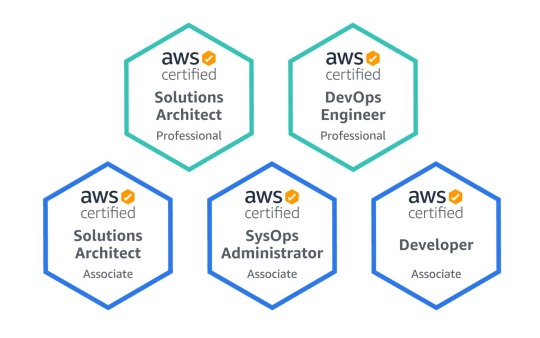
In today's modern digital world, the heart of the business operations lies in cloud computing. Among all the cloud platforms, the most widely accepted and versatile provider of cloud services is Amazon Web Services (AWS). As a result, there is a massive demand for cloud solution designers and managers. The role that has gained much importance is that of an AWS Solutions Architect.
What is an AWS Solutions Architect?
An AWS solutions architect is the professional designing, deploying, and managing applications and systems on the AWS platform. Such architects work with companies to identify needs and then utilize the AWS suite of services in order to create secure, scalable, and cost-effective solutions. This role thus demands a very good understanding of the services, best practices related to architecture, and the business or industry requirements being addressed.
Key Responsibilities of AWS Solution Architect
Designing such an effective cloud solution that ensures scalability and dependability is quite a big duty of designing cloud solutions in a remit defined by the term AWS solution architectures. Other ones include selection for the best suitability of services pertaining to companies into AWS, keeping security compliance over the system design, and constructing architecture with perfect performance at cheap cost.
Most of these consultants work directly with clients to understand their technical and business requirements. They work with various stakeholders to deliver, among others, guidance of technical nature to make deliveries that are aimed at customizing solutions to fit the business requirements.
Security and Compliance. Cloud computing places a high priority on security, and the AWS Solutions Architects ensure that their solution designs meet the requirements of industry standards and regulatory compliance. They use encryption, access controls, and network security protocols to secure systems and data.
Optimization and Cost Management: AWS services are flexible and come in various configurations. A cloud architect designing an AWS solution should optimize cloud resources for both performance and cost. This is achieved through choosing the correct pricing models, resource allocation management, and regular review of the architecture to determine the potential areas of improvement.
Troubleshooting and Support: An AWS Solutions Architect should be able to diagnose issues and provide ongoing support for cloud-based applications and systems. This includes monitoring system performance, identifying potential problems, and applying solutions as needed.
Essential Skills for an AWS Solutions Architect
Deep knowledge of various AWS services: An AWS Solutions Architect must be pretty well aware of each and every one of the differing AWS services. Such as EC2, S3, RDS, Lambda, VPC, and the likes. He must know how to combine those services to create comprehensive cloud solutions.
Architectural best practices: He has to be an expert in designing highly secure, scalable, and highly available cloud architecture. Familiarity with AWS Well-Architected Framework is a plus.
Security Expertise: Security happens to be an important consideration on the cloud. An AWS Solution Architect should, therefore, have a clue how to design secured infrastructures employing tools such as AWS Identity and Access Management, encryption, firewall, and other monitoring services.
Analytical and Problem-Solving Skills: For the reason that each cloud solution is unique in nature, Amazon Web Services solutions architects need a high degree of analytical and problem-solving skills, to develop tailored solutions for all their needs.
Communication Skills : An AWS Solutions Architect will always be in contact with various clients, developers and stakeholders. The ability to get the technical concept spoken in simple words is essential as well as business requirements to technical requirements.
Certifications for AWS Solutions Architects
A degree in computer science or related field is helpful but most of the time certifications are required to prove expertise. The AWS Certified Solutions Architect – Associate is a very popular certification for those in this role. This ensures the candidate can design distributed systems on AWS and solve complex problems while implementing AWS security best practices. In addition, there is an AWS Certified Solutions Architect – Professional level certification that is considered advanced and for the application of large-scale architectures.
Career Prospects and Salary Expectations
More businesses are shifting to the cloud and it is sure to increase more and more demand for AWS Solutions Architects. Reports have shown that an AWS Solutions Architect earns very competitive salaries with average salary being reported to be $120,000 to $150,000 for a solutions architect in the United States based on experience and location. Those professionals who hold a senior designation and specialized certification tend to draw a higher wage.
Secondly, the AWS Solutions Architects have better career prospects. They can reach senior technical roles, cloud engineering, and also lead in architecture roles in cloud architecture.
Conclusion
The emergent role of an AWS Solutions Architect becomes increasingly important with the adoption of the cloud in businesses. The role is responsible not only for designing and implementing a cloud-based solution but also with the responsibility of creating conditions that enable an organization to exploit the AWS platform fully. With the right skills, knowledge, and certifications, a career as an AWS Solutions Architect can be incredibly satisfying and rewarding.
0 notes
Text
Introduction to Amazon Redshift for Data Warehousing

Introduction to Amazon Redshift for Data Warehousing Amazon Redshift is a fully managed, petabyte-scale cloud data warehouse service designed to handle large-scale data storage and analytical workloads.
It enables organizations to run complex queries across massive datasets efficiently, leveraging its columnar storage architecture and parallel processing capabilities.
Key Features of Amazon Redshift
Columnar Storage — Data is stored in columns instead of rows, improving query performance for analytical workloads.
Massively Parallel Processing (MPP) — Distributes workloads across multiple nodes for fast query execution.
Scalability — Supports dynamic scaling to handle growing datasets and workloads. Integration with AWS Services — Easily integrates with S3, AWS Glue, AWS Lambda, and more.
Security & Compliance — Offers encryption, VPC isolation, and compliance with industry standards.
Cost-Efficiency — Uses compression and automatic workload management to optimize costs.
How Amazon Redshift Works Cluster-Based Architecture — A Redshift cluster consists of a leader node and compute nodes that process queries in parallel.
Data Loading — Data is ingested from sources like Amazon S3, DynamoDB, and on-premises databases.
Query Execution — Uses SQL-based queries optimized for performance using distribution and sort keys.
Data Sharing — Supports cross-cluster data sharing for better collaboration.
Use Cases of Amazon Redshift Business intelligence and reporting ETL (Extract, Transform, Load) workflows Machine learning and predictive analytics Real-time analytics and dashboarding Data lake integration for unified analytics
WEBSITE: https://www.ficusoft.in/aws-training-in-chennai/
0 notes
Text
Amazon Timestream helps AWS InfluxDB databases
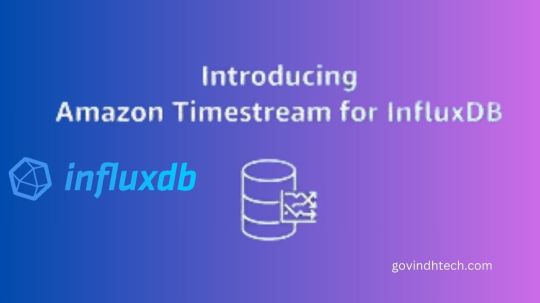
InfluxDB on AWS
AWS InfluxDB
As of right now, Amazon Timestream supports InfluxDB as a database engine. With the help of this functionality, you can easily execute time-series applications in close to real-time utilizing InfluxDB and open-source APIs, such as the open-source Telegraf agents that gather time-series observations.
InfluxDB vs AWS Timestream
Timestream now offers you a choice between two database engines: Timestream for InfluxDB and Timestream for LiveAnalytics.
If your use cases call for InfluxDB capabilities like employing Flux queries or near real-time time-series queries, you should utilize the Timestream for InfluxDB engine. If you need to conduct SQL queries on petabytes of time-series data in seconds and ingest more than tens of terabytes of data per minute, the Timestream for LiveAnalytics engine currently in use is a good alternative.
You may utilize a managed instance that is automatically configured for maximum availability and performance with Timestream’s support for InfluxDB. Setting up multi-Availability Zone support for your InfluxDB databases is another way to boost resilience.
Timestream for LiveAnalytics and Timestream for InfluxDB work in tandem to provide large-scale, low-latency time-series data intake.
How to create database in InfluxDB
You can start by setting up an instance of InfluxDB. Now you can open the Timestream console, choose Create Influx database under InfluxDB databases in Timestream for InfluxDB.
You can provide the database credentials for the InfluxDB instance on the next page.
You can also define the volume and kind of storage to meet your requirements, as well as your instance class, in the instance configuration.
You have the option to choose either a single InfluxDB instance or a multi-Availability Zone deployment in the following section, which replicates data synchronously to a backup database in a separate Availability Zone. Timestream for InfluxDB in a multi-AZ deployment will immediately switch to the backup instance in the event of a failure, preserving all data.
Next, you can set up your connectivity setup to specify how to connect to your InfluxDB instance. You are able to configure the database port, subnets, network type, and virtual private cloud (VPC) in this instance. Additionally, you may choose to make your InfluxDB instance publicly available by configuring public subnets and setting the public access to publicly accessible. This would enable Amazon Timestream to provide your InfluxDB server with a public IP address. Make sure you have appropriate security measures in place to safeguard your InfluxDB instances if you decide to go with this option.
You had been configured your InfluxDB instance to be not publicly available, which restricts access to the VPC and subnets you specified earlier in this section.
You may provide the database parameter group and the log delivery settings once you’ve set up your database connection. You may specify the adjustable parameters your wish to utilize for your InfluxDB database in the parameter group. You may also specify which Amazon Simple Storage Service (Amazon S3) bucket you have to export the system logs from in the log delivery settings. Go to this page to find out more about the Amazon S3 bucket’s mandatory AWS Identity and Access Management (IAM) policy.
After that are you satisfied with the setup, you can choose Create Influx database.
You can see further details on the detail page once your InfluxDB instance is built.
You can now access the InfluxDB user interface (UI) once the InfluxDB instance has been established. By choosing InfluxDB UI in the console, you may see the user interface if you have your InfluxDB set up to be publicly available. As instructed, you made your InfluxDB instance private. SSH tunneling is needed to access the InfluxDB UI from inside the same VPC as my instance using an Amazon EC2 instance.
The URL endpoint from the detail page lets me connect in to the InfluxDB UI using your username and password from creation.Image credit to AWS
Token creation is also possible using the Influx command line interface (CLI). You can establish a setup to communicate with your InfluxDB instance before you generate the token.
You may now establish an operator, all-access, or read/write token since you have successfully built the InfluxDB setup. An example of generating an all-access token to authorize access to every resource inside the specified organization is as follows:
You may begin feeding data into your InfluxDB instance using a variety of tools, including the Telegraf agent, InfluxDB client libraries, and the Influx CLI, after you have the necessary token for your use case.
At last, you can use the InfluxDB UI to query the data. You can open the InfluxDB UI, go to the Data Explorer page, write a basic Flux script, and click Submit.
You may continue to use your current tools to communicate with the database and create apps utilizing InfluxDB with ease thanks to Timestream for InfluxDB. You may boost your InfluxDB data availability with the multi-AZ setup without having to worry about the supporting infrastructure.
AWS and InfluxDB collaboration
In celebration of this launch, InfluxData’s founder and chief technology officer, Paul Dix, shared the following remarks on this collaboration:
The public cloud will fuel open source in the future, reaching the largest community via simple entry points and useful user interfaces. On that aim, Amazon Timestream for InfluxDB delivers. Their collaboration with AWS makes it simpler than ever for developers to create and grow their time-series workloads on AWS by using the open source InfluxDB database to provide real-time insights on time-series data.
Important information
Here are some more details that you should be aware of:
Availability:
Timestream for InfluxDB is now widely accessible in the following AWS Regions: Europe (Frankfurt, Ireland, Stockholm), Asia Pacific (Mumbai, Singapore, Sydney, Tokyo), US East (Ohio, N. Virginia), and US West (Oregon).
Migration scenario:
Backup InfluxDB database
You may easily restore a backup of an existing InfluxDB database into Timestream for InfluxDB in order to move from a self-managed InfluxDB instance. You may use Amazon S3 to transfer Timestream for InfluxDB from the current Timestream LiveAnalytics engine. Visit the page Migrating data from self-managed InfluxDB to Timestream for InfluxDB to learn more about how to migrate data for different use cases.
Version supported by Timestream for InfluxDB: At the moment, the open source 2.7.5 version of InfluxDB is supported.
InfluxDB AWS Pricing
Visit Amazon Timestream pricing to find out more about prices.
Read more on govindhtech.com
#amazon#aws#influxdb#liveanalytics#sqlqueries#amazons3#amazonec2#vpc#technology#technews#govindhtech
0 notes
Text
aws cloud,
aws cloud,
Amazon Web Services (AWS) is one of the leading cloud computing platforms, offering a wide range of services that enable businesses, developers, and organizations to build and scale applications efficiently. AWS provides cloud solutions that are flexible, scalable, and cost-effective, making it a popular choice for enterprises and startups alike.
Key Features of AWS Cloud
AWS offers an extensive range of features that cater to various computing needs. Some of the most notable features include:
Scalability and Flexibility – AWS allows businesses to scale their resources up or down based on demand, ensuring optimal performance without unnecessary costs.
Security and Compliance – With robust security measures, AWS ensures data protection through encryption, identity management, and compliance with industry standards.
Cost-Effectiveness – AWS follows a pay-as-you-go pricing model, reducing upfront capital expenses and providing cost transparency.
Global Infrastructure – AWS operates data centers worldwide, offering low-latency performance and high availability.
Wide Range of Services – AWS provides a variety of services, including computing, storage, databases, machine learning, and analytics.
Popular AWS Services
AWS offers numerous services across various categories. Some of the most widely used services include:
1. Compute Services
Amazon EC2 (Elastic Compute Cloud) – Virtual servers for running applications.
AWS Lambda – Serverless computing that runs code in response to events.
2. Storage Services
Amazon S3 (Simple Storage Service) – Object storage for data backup and archiving.
Amazon EBS (Elastic Block Store) – Persistent block storage for EC2 instances.
3. Database Services
Amazon RDS (Relational Database Service) – Managed relational databases like MySQL, PostgreSQL, and SQL Server.
Amazon DynamoDB – A fully managed NoSQL database for fast and flexible data access.
4. Networking & Content Delivery
Amazon VPC (Virtual Private Cloud) – Secure cloud networking.
Amazon CloudFront – Content delivery network for faster content distribution.
5. Machine Learning & AI
Amazon SageMaker – A fully managed service for building and deploying machine learning models.
AWS AI Services – Includes tools like Amazon Rekognition (image analysis) and Amazon Polly (text-to-speech).
Benefits of Using AWS Cloud
Organizations and developers prefer AWS for multiple reasons:
High Availability – AWS ensures minimal downtime with multiple data centers and redundant infrastructure.
Enhanced Security – AWS follows best security practices, including data encryption, DDoS protection, and identity management.
Speed and Agility – With AWS, businesses can deploy applications rapidly and scale effortlessly.
Cost Savings – The pay-as-you-go model reduces IT infrastructure costs and optimizes resource allocation.
Getting Started with AWS
If you are new to AWS, follow these steps to get started:
Create an AWS Account – Sign up on the AWS website.
Choose a Service – Identify the AWS services that suit your needs.
Learn AWS Basics – Use AWS tutorials, documentation, and training courses.
Deploy Applications – Start small with free-tier resources and gradually scale.
Conclusion
AWS Cloud is a powerful and reliable platform that empowers businesses with cutting-edge technology. Whether you need computing power, storage, networking, or machine learning, AWS provides a vast ecosystem of services to meet diverse requirements. With its scalability, security, and cost efficiency, AWS continues to be a top choice for cloud computing solutions.
0 notes
Video
youtube
How to Scale Amazon RDS | Optimize Database Performance and Capacity
Step 1: Access the Amazon RDS Console - Log in to the AWS Management Console. - Navigate to the RDS service.
Step 2: Vertical Scaling - Modify Instance Size - Select the RDS instance you want to scale from the Databases section. - Click on "Modify." - Choose a larger DB instance class under Instance specifications. - Click "Continue," then "Modify DB Instance." - Choose whether to apply the change immediately or during the next maintenance window.
Step 3: Horizontal Scaling - Set Up Read Replicas - Select the RDS instance you want to replicate. - Click on "Actions," then "Create read replica." - Choose the DB instance class and Multi-AZ options if required. - Configure the VPC, subnet group, and security groups. - Click "Create read replica."
Step 4: Enable Multi-AZ Deployment - Select your RDS instance from the Databases section. - Click on "Modify." - Under Availability & durability, check the Multi-AZ deployment option. - Click "Continue," then "Modify DB Instance."
Step 5: Monitor Performance - In the RDS console, navigate to Monitoring. - Review metrics such as CPU utilization, memory usage, disk I/O, and database connections. - Use these metrics to determine if further scaling is necessary.
***************************** *Follow Me* https://www.facebook.com/cloudolus/ | https://www.facebook.com/groups/cloudolus | https://www.linkedin.com/groups/14347089/ | https://www.instagram.com/cloudolus/ | https://twitter.com/cloudolus | https://www.pinterest.com/cloudolus/ | https://www.youtube.com/@cloudolus | https://www.youtube.com/@ClouDolusPro | https://discord.gg/GBMt4PDK | https://www.tumblr.com/cloudolus | https://cloudolus.blogspot.com/ | https://t.me/cloudolus | https://www.whatsapp.com/channel/0029VadSJdv9hXFAu3acAu0r | https://chat.whatsapp.com/D6I4JafCUVhGihV7wpryP2 *****************************
*🔔Subscribe & Stay Updated:* Don't forget to subscribe and hit the bell icon to receive notifications and stay updated on our latest videos, tutorials & playlists! *ClouDolus:* https://www.youtube.com/@cloudolus *ClouDolus AWS DevOps:* https://www.youtube.com/@ClouDolusPro *THANKS FOR BEING A PART OF ClouDolus! 🙌✨*
#youtube#Optimizing Database Performance with Amazon RDSScaling Your Amazon RDS Instance Vertically and HorizontallyHow can I improve my RDS performa#amazon rds database S3 aws devops amazonwebservices free awscourse awstutorial devops awstraining cloudolus naimhossenpro ssl storage cloudc
0 notes
Text
From Novice to Pro: Master the Cloud with AWS Training!
In today's rapidly evolving technology landscape, cloud computing has emerged as a game-changer, providing businesses with unparalleled flexibility, scalability, and cost-efficiency. Among the various cloud platforms available, Amazon Web Services (AWS) stands out as a leader, offering a comprehensive suite of services and solutions. Whether you are a fresh graduate eager to kickstart your career or a seasoned professional looking to upskill, AWS training can be the gateway to success in the cloud. This article explores the key components of AWS training, the reasons why it is a compelling choice, the promising placement opportunities it brings, and the numerous benefits it offers.

Key Components of AWS Training
1. Foundational Knowledge: Building a Strong Base
AWS training starts by laying a solid foundation of cloud computing concepts and AWS-specific terminology. It covers essential topics such as virtualization, storage types, networking, and security fundamentals. This groundwork ensures that even individuals with little to no prior knowledge of cloud computing can grasp the intricacies of AWS technology easily.
2. Core Services: Exploring the AWS Portfolio
Once the fundamentals are in place, AWS training delves into the vast array of core services offered by the platform. Participants learn about compute services like Amazon Elastic Compute Cloud (EC2), storage options such as Amazon Simple Storage Service (S3), and database solutions like Amazon Relational Database Service (RDS). Additionally, they gain insights into services that enhance performance, scalability, and security, such as Amazon Virtual Private Cloud (VPC), AWS Identity and Access Management (IAM), and AWS CloudTrail.
3. Specialized Domains: Nurturing Expertise
As participants progress through the training, they have the opportunity to explore advanced and specialized areas within AWS. These can include topics like machine learning, big data analytics, Internet of Things (IoT), serverless computing, and DevOps practices. By delving into these niches, individuals can gain expertise in specific domains and position themselves as sought-after professionals in the industry.

Reasons to Choose AWS Training
1. Industry Dominance: Aligning with the Market Leader
One of the significant reasons to choose AWS training is the platform's unrivaled market dominance. With a staggering market share, AWS is trusted and adopted by businesses across industries worldwide. By acquiring AWS skills, individuals become part of the ecosystem that powers the digital transformation of numerous organizations, enhancing their career prospects significantly.
2. Comprehensive Learning Resources: Abundance of Educational Tools
AWS training offers a wealth of comprehensive learning resources, ranging from extensive documentation, tutorials, and whitepapers to hands-on labs and interactive courses. These resources cater to different learning preferences, enabling individuals to choose their preferred mode of learning and acquire a deep understanding of AWS services and concepts.
3. Recognized Certifications: Validating Expertise
AWS certifications are globally recognized credentials that validate an individual's competence in using AWS services and solutions effectively. By completing AWS training and obtaining certifications like AWS Certified Solutions Architect or AWS Certified Developer, individuals can boost their professional credibility, open doors to new job opportunities, and command higher salaries in the job market.
Placement Opportunities
Upon completing AWS training, individuals can explore a multitude of placement opportunities. The demand for professionals skilled in AWS is soaring, as organizations increasingly migrate their infrastructure to the cloud or adopt hybrid cloud strategies. From startups to multinational corporations, industries spanning finance, healthcare, retail, and more seek talented individuals who can architect, develop, and manage cloud-based solutions using AWS. This robust demand translates into a plethora of rewarding career options and a higher likelihood of finding positions that align with one's interests and aspirations.

In conclusion, mastering the cloud with AWS training at ACTE institute provides individuals with a solid foundation, comprehensive knowledge, and specialized expertise in one of the most dominant cloud platforms available. The reasons to choose AWS training are compelling, ranging from the industry's unparalleled market position to the top ranking state.
9 notes
·
View notes